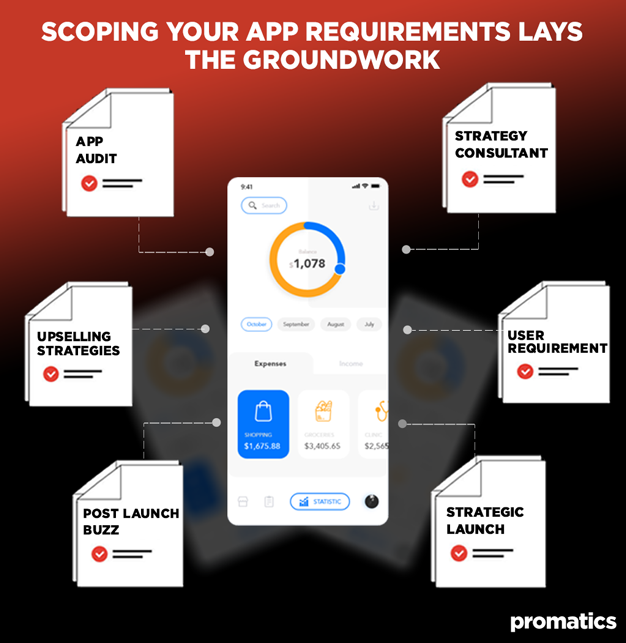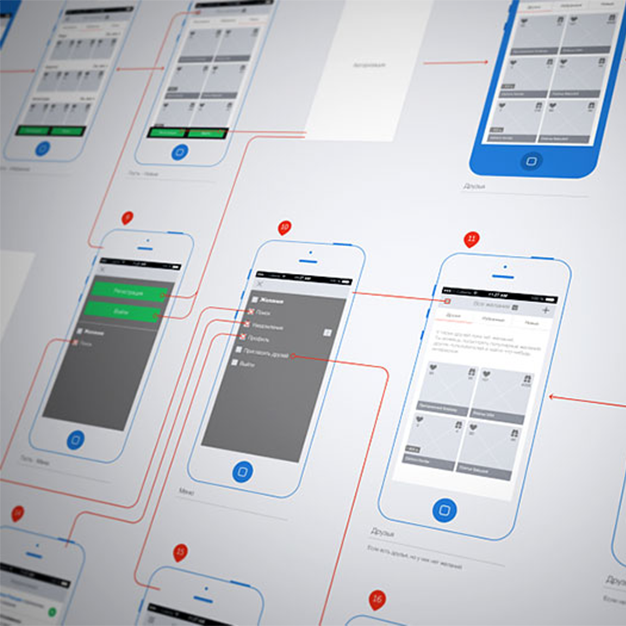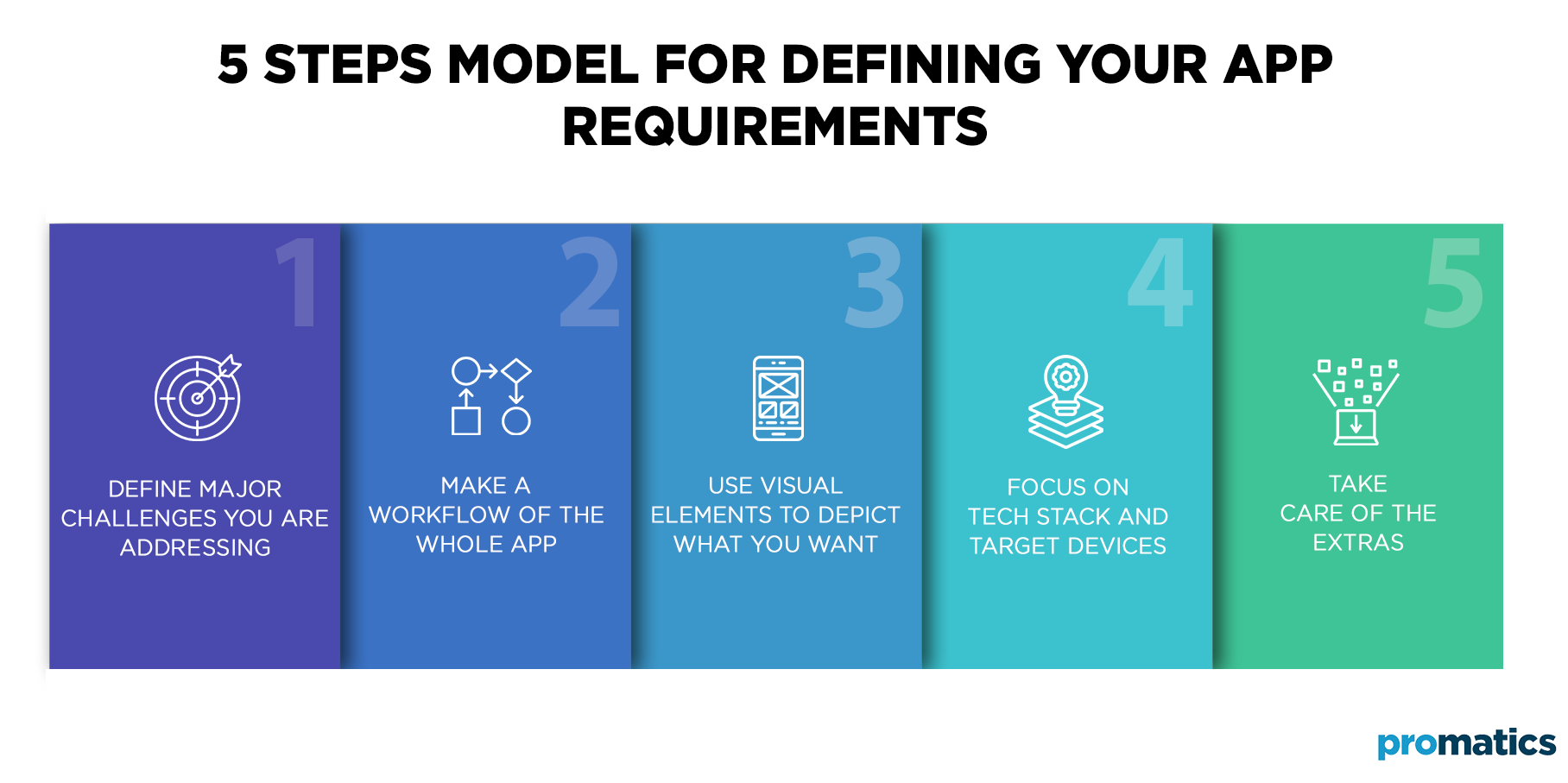How to Define Your Mobile App Project Requirements in 5 Easy Steps?
With the rise in technology, people have forgotten about arcade games, hopscotch, even going to the supermarket. Everything has moved on to phones and laptops. Hence, the rise in the use of Mobile Apps.
Designing and launching a Mobile App is not a piece of cake. Instead, it requires thorough planning and pure hard work. Months and months of planning, many setbacks, and tons of resources are needed to launch high quality and technologically upgraded Mobile App.
One that does not work properly crashes frequently or is of low quality will not attract customers. When planning a Mobile App Project, you must set targets and goals that give your whole project a sense of purpose.
Keep reading to find out in detail why precise requirements for your Mobile App are necessary for the success of your new project.
Why is Scoping Precise App Requirements Necessary
It is self-evident that clear goals and requests will have a great hand in the profitability and success of your Mobile App Project.
But how will having a clear direction help you in the short run?
Investing in software projects is not cheap. With the rising cost of technology, product development costs are increasing day by day.
Scoping a Mobile App Project allows you to plan not only for the short term but also how the product will be adapted in the long run. What does this mean?
Due to the fast pace of changes in the market and consumer preferences, a product like Mobile App can quickly become outdated, especially with so many competitors in the market now.
That’s when scoping requirements help you. Scoping the project and its requirements will ensure that your Mobile App adapts to changes in the market, features that will be useful in the future, and a plan that doesn’t need to be revoked.
Now that we know the importance of having precise scoping requirements for our Mobile App let’s take a look at what these requirements/steps are.
List Your App Requirements in These 5 Simple Steps
Step 1 – Precisely List Down Your Challenges
App development is not easy! The process is filled with problems and challenges. One of these major ones is finance. Getting the product developed and the launching and maintenance of the app is not a cheap task. So you need to have a pool of funds and then some more.
Make sure your app developer knows about the finance at hand. If you are running on a tight budget make sure you communicate this constraint with your app developer so they don’t overstretch their resources and yours too.
You must draw up a business plan allowing you to have a reality check, getting to know how much you can afford to spend before running out, and it will make it much easier for the app developer to know their limits. Share your budget planning with the app developer.
Besides Funding, when developing a mobile app, many face the problem of overall poor performance. This bad performance can be the result of poor device compatibility.
This means the app is not working on various devices but only limited in return, limiting your profit. Therefore, you need to clarify what you are aiming for to the app developer, allowing them to develop a Mobile App that works perfectly with suitable screen resolutions, pixels, and sizes.
Standing out from a pool of other apps is a stern challenge faced by every mobile app.
Your app may be the perfect one, but if it doesn’t stand out from the rest in the industry, it will not be a successful one, forcing you to draw it out from the market. So how do you present your app as a different one? Devise a plan with the app developer as they know what the consumers are demanding and what they like, giving your input here and there.
Plan out a branding strategy, one that will help your app to take the lead in the market. Once a strategy has been devised, communicate it with the app developer, so they know what direction to take on and how the app will adjust to your scheme.
Step 2 – Arrange the Workflow of Your App
Planning out the workflow for your app will save both your time and the app developers.
When constructing a Workflow you need to include the following;
First, in line, we have the prototype. This will cover the user experience with the app. Once you have covered that, you’ll include in the workflow, UX which is more concerned with the aesthetics of your app. Special attention needs to be given to conversion screens when planning out the workflow.
Once done with the prototype stage, you have built. Ask the app developer to include agile methodology when coding as it will keep a tracker of orders and delivery time.
The workflow of an app should also include the testing process. Make sure the app developer runs the mobile app on various devices to detect any bugs. Bring in a few people and ask them to use the app. Ask for their feedback.
As the Workflow covers all the stages of product development, it will also cover the launching process and its details. You’ll have to decide on descriptions, keywords, and titles.
Make sure your workflow includes marketing strategies that are effective. These strategies can include social media advertisements, etc.
At the end of the workflow, upgrades will be covered. This is essential as due to the fast and changing pace of technology and consumer demands, apps can become outdated if they don’t adapt to consumer trends. Make sure you are ready by already planning for new features
Keep your head straight and stay firm on your decision. Make sure to tell all of your plans to the app developer, so they don’t create a worthless app.
Step 3 – Take the Help of Visual Elements
When talking about the designs of an app, you have to focus on both UX and UI.
User interface decisions determine the buttons and icons that will be used by the users to interact with the app. UI components also include screens, touchscreen, lights, keyboards, and even sounds.
On the other hand, a well-built UX focuses on the user experience. How they feel about the app, whether they like it or not.
You’ll need to make it clear when mapping out your requirements which aspect you want to prioritize more, UX or UI?
To make things easier for you and the app developer, take the help of wireframes. Drawing up one will provide you and the app developer with a vision to work towards. An app wireframe is a visual illustration of how you expect the users to use the app. It will exactly tell the app developer how you want the mobile app to work. The wireframe of your app will make it clear to the app developer how they should situate content on the screen, controls, and navigations.
If possible, attach references for the app so the app developer has a better idea of what you want and what they should work towards. Decide upon the standard features that you want within the app, and prioritize them allowing the app developer to know what they should focus on first. In order to choose importance, you can adapt the Moscow Method which allows you to list items according to the “Must”, ” Should”, “Could” and “Won’t ” levels of priority.
Step 4 – Zero In on Device Details
You ought to decide which devices the app could run on—either Android or iOS or both. If you plan on operating your app under the Android banner, it will be targeted at more people since Android dominates.
On the flip side of the coin, if you go for iOS you have better chances of monetizing the app. Apple is considered premium and Android mass market. Whatever the prices, people will still buy Apple because of it’s high-quality and brand image. So if you are targetting an affluent audience you cannot miss Apple.
When planning out product development, it is necessary to decide upon the technology you wish to choose. In that regard, there are three excellent options to choose from: Hybrid App, Platform Specific Native App, and Cross-Platform Native App.
Hybrid App is a technological system that is suitable for all devices and operating systems. Whether it is Android or iOS doesn’t matter. The greatest perk of using this approach is that it is cost-effective. To put it simply, it will be cheaper.
Native Apps can either be used for iOS or Android as they are specifically coded. This approach focuses more on enhancing your user’s experience.
Cross-Platform Native App, on the other hand, is a cheaper option than the Native Apps as all the apps developed under this approach share the same SDKs. Examples of apps using this approach include Flutter and React Native.
You will also need to decide whether you want your app to be displayed in landscape or portrait mode. The main difference between the two is that an app in landscape mode is represented to the users in a horizontal layout while a portrait mode is a vertical one. Whatever you choose, convey the message to your app developer.
Make sure you explore all your options before settling down for one and communicating it with your app developer.
Step 5 – Tiding Up The Loose Ends
If your app is not secured, your whole system will be at risk of damage. Add Single Sign On (SSO) feature, Biometric Authentication, Two Step Authentication, SSL encryption for the app etc. So prioritize safety matters and make sure your app developer knows this too.
Make sure you plan out a list of standard features so that the app developer knows what they are in for. These features can include onboarding, navigation, login/logout, social media integration, third-party integration, etc.
Once you’re done with finalizing all this, decide upon the format of your app. One of the most common ones is FSD also known as Functional Specification Document. A FSD will cover points like what the display screen will show, and what will happen if the users opt for different features etc.
Additional Tips to Gather Your App Requirements
Drawing out requirements and specifying them can be a confusing process, especially for those who have never done that before. Here’s a tip for you, review other apps that are already in the market. Study and assess them, note down their features that you want to include in your mobile app, etc. Mention the app that you specifically like to your app developer. It will also make things easier for them.
Conclusion
When investing money in a Mobile App Project, you need to be right the first time. There’s no room for mistakes. Therefore spend enough time clearly perfecting your app requirements brief so that the app development company and you are both on the same platform.
Still have your concerns?
Your concerns are legit, and we know how to deal with them. Hook us up for a discussion, no strings attached, and we will show how we can add value to your operations!


